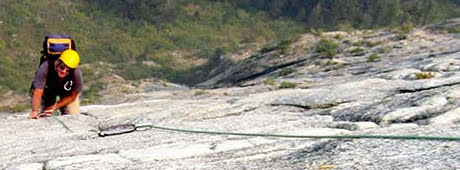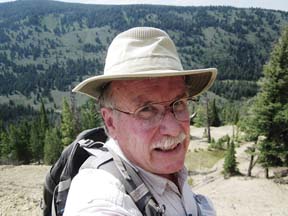No products in the cart.
Slippery Slick Rock

No Way but Up
Story and Photos by Ray Brooks
My friend Mike Paine was not a patient man. In 1981, when Alpine Club climbers from Washington State University blocked access to the usual start up the Three Cracks Route of Slick Rock in Payette National Forest, Mike’s course of action was to start up an enticing blank slab to the left that I had pointed out to him a few weeks earlier.
The problem was that it was “unprotectable,” meaning there was no place to affix a piton or other gear that would secure his climbing rope. When he was about ten feet up, he was able to establish a good piece of protection. After that, he climbed and climbed on beautiful smooth crackless granite, never finding a spot to place more protection.
Finally, after many minutes of bold but very careful slab climbing, with nothing but finger-wide down-sloping ledges to cling to, a “thank God” ledge loomed close above him. He had just enough length left in his 150-foot rope to reach safety.
Unfortunately, one of the last holds he grabbed peeled from the rock, and Mike went with it. He later told me that during the first seconds of falling, he had time to think several times over, “This is going to kill me,” before he was knocked out.
I wasn’t there that day, but eyewitnesses agreed the fall was spectacular. Apparently, Mike slid backward for a while and then started taking bigger and bigger bounces, up to thirty feet long. Luckily for him, Slick Rock has a base of only somewhat sleep rock slabs, upon which climbers don’t feel the need to use ropes. When he reached this lower-angled base, he began the long bounces down the slabs. Finally, after he fell about 260 feet, the rope stopped him.
He hung upside down in a low-angled corner and when he woke up, he was unable to see because of blood running into his eyes. But he realized he had lived through a killer fall.
He later told me, “I thought: ‘I’m alive, but I’ve paid the price. I must have broken every bone in my body.’”
This content is available for purchase. Please select from available options.
Register & Purchase Purchase Only
Register & Purchase Purchase Only


3 Responses to Slippery Slick Rock
Tom Boley -
at
Fun article, Ray! Have to get up there before I can’t climb 5.7 anymore!
Dana Quinney -
at
Great adventures!
Kim Miller -
at
Really good reading Ray. I always enjoy the way you write and describe climbing adventures. Good job doing the route in your 60’s – impressive! I remember coming down that descent a few years back and my biggest fear was stumbling upon a bear eating the fresh berries. I made a lot of noice.